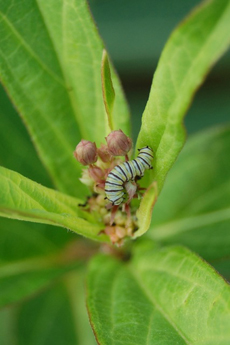Raise and release: docent devoted to monarchs
 |
A monarch caterpillar navigates swamp milkweed. Photo: Vicki Williams |
A monarch butterfly crawls onto Vicki Williams' finger, its legs gently pinching her skin. It sits for a minute and then takes off, fluttering orange wings threaded with black. During the summer, Williams, a docent at Fermilab, raises monarch eggs and caterpillars. She releases them after they metamorphose into butterflies.
"You just feel kind of immersed in nature for a few minutes," Williams said about the release. "And in the moment, because you have to be careful. They're fresh. They're brand new to the world again."
This year, Williams brought some monarchs from home to share with students visiting the Lederman Science Center. Sue Sheehan, education program leader, says that Williams' monarchs thrilled the children, and even the adults.
"We had a visitor the other day who exclaimed, 'Oh my gosh, this is so cool! I've never seen one!'" Sheehan said. "Everybody gets excited about it."
Monarchs, the state insect of Illinois, visit Fermilab and surrounding areas from about May until late September. When they leave in the fall, they fly south to overwintering sites in Mexico, one leg of a relay-esque, multigenerational migration.
The number of monarchs at overwintering sites has plummeted in recent years. Tom Peterson, engineer and amateur lepidopterist, says the decline in monarchs is likely due to multiple factors.
"One of them is probably that there is less milkweed around for them to feed on as caterpillars," he said. Milkweed is often eradicated from roadsides and crop fields, but it's the only thing a monarch caterpillar eats.
To address monarchs' decline, some people plant milkweed at home. Williams offers monarchs something extra by rearing them inside: Protection.
"I think they might have a little bit better chance of survival because they're not prey to the elements, they're not prey to predators," Williams said.
Williams collects monarch eggs and caterpillars from milkweed in her garden. Usually, she houses them in cages made of mesh and plastic. This year she had so many she had to keep them in a baking dish covered with perforated plastic wrap. She cleans their space and feeds them fresh milkweed every day.
"I'll do it again every year until I can't," Williams said. She hopes that giving people an up-close look at her monarchs will nurture their connection to nature.
—Chris Patrick
|